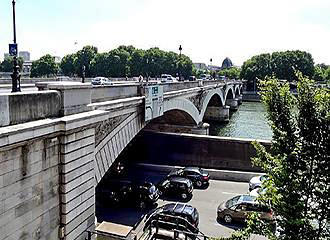Pont d’Austerlitz bridge in Paris
A bridge was first constructed during the reign of Napoleon Bonaparte, yet having been replaced and then altered and widened, the Pont d’Austerlitz we can see today dates from the latter part of the 1800s.
A bit of history
The need for a bridge between the left bank by the fabulous Jardin des Plantes going over the River Seine to the right bank was originally discussed in the latter part of the 1700s after several unsuccessful attempts at creating a bridge had failed.
In fact, in 1773 there was a project for a wooden bridge, which was designed by Jean-Baptiste Perronet, yet there were many different ideas including that of a ferry service and another for a metal bridge.
But it was eventually in 1801 that the decision was taken to construct a cast iron bridge with five arches resting on four piers with two stone abutments, and having been designed by the engineer Becquey de Beaupre, the arches were placed upon metal pads in order to prevent damage from vibration, and this was constructed between 1804 and 1806.
However, by the start of the 1850s, the bridge was felt to be too dangerous and then by 1854 it was being completely reconstructed under the supervision of the architects and engineers Alexandre Michal and Jules Savarin, yet this time it was designed with stone arches, although the existing piers were reused and strengthened.
But yet again, this bridge over the River Seine was proved to be inadequate, although not by the structural integrity this time, but purely because of the growing traffic within the city, where it was deemed to be too narrow, and so, the bridge was then widened.
About Pont d’Austerlitz over the River Seine
The Pont d’Austerlitz was first inaugurated with its current name in 1854, and was named after the Battle of Austerlitz, which was one of the greatest victories for Napoleon Bonaparte.
And although this bridge in Paris underwent major alterations in 1884 through to 1885, which was designed by the architect Jean-marie Georges Choquet and supervised by the engineer Guiard, so as to widen the Pont Austerlitz to its current width of 30 metres and just under 174 metres long, it has still kept its name to this day, and is now classed as one of the historical monuments in Paris.
In addition to this, you will not see the crowned Imperial N surrounded by laurel branches that were located on the tympana at each pier and abutment on the originally first bridge, as these have been replaced with a decoration made of masonry that looks like a shield with a lions face and two scrolls either side, which are designed to represent the Republic.
Visiting Pont d’Austerlitz in Paris
You will find that the Pont d’Austerlitz connects the 12th Arrondissement in between the Bassin de l’Arsenal on the Canal Saint-Martin and the Bercy area, going over to the border between the 5th and 13th Arrondissements on the left bank of the River Seine by the Jardin des Plantes.
And this bridge is also now a major crossing point connecting the Gare d’Austerlitz train station and the Gare de Lyon train station, which is where you can discover the fabulous Train Bleu restaurant, yet both of these train stations in Paris were constructed after the Pont d’Austerlitz was put in place.
But to get your bearings on the River Seine, the next bridge downstream is the Pont de Sully at the tip of the Ile saint Louis, whereas upstream you have the Viaduc d’Austerlitz and then the Pont Charles de Gaulle.
And when it comes to public transport in Paris, you will find that the nearest Metro station to the Pont d’Austerlitz is the Quai de la Rapee stop via line 5, or on the opposite bank you have the Gare d’Austerlitz Metro stop via lines 5 or 10, plus there is also the RER train stop on line C along with other trains that go far further afield from the main station.



